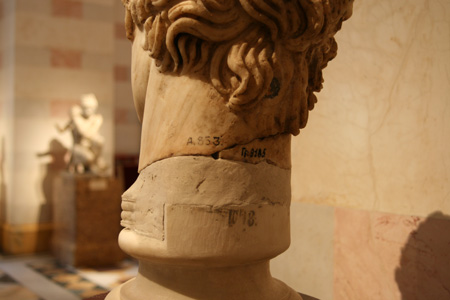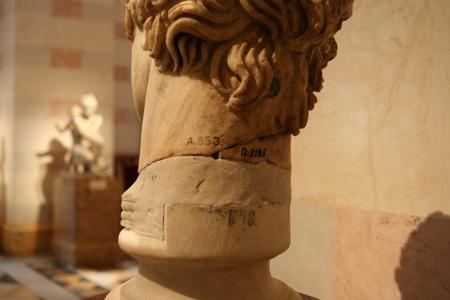Last month I fulfilled a lifelong dream of visiting the Hermitage museum in St. Petersburg, Russia. When I was there, I noticed a number of large notations applied directly on the backs of some of the sculptures on view.

Marks like those pictured above are used for recordkeeping purposes at museums, but these seemed particularly bold to me. When I returned to Los Angeles, I asked Tiffany Shea in our registrar’s office about what I saw, and her responses were so interesting that we thought we’d do a short series about keeping tabs on a museum’s permanent collection.
To kick things off, a little background on museum recordkeeping. The system itself of writing collection numbers on artworks stems from a time well before photography. (Imagine—no websites to determine what was in a storeroom or even hard copies of images to reference in files.) Not surprisingly, each and every artwork in a museum’s collection must be marked with its own number so that it can easily be identified, tracked, and located in perpetuity. These marks are often used to signify good provenance (ownership history) of the artwork and can thus increase the value of the work itself. Some numbers refer to important, old European private collections while others refer to exhibitions at prestigious exhibitions to which the artworks were lent. Still others refer to the year an object was brought into a museum’s collection, or “accessioned,” as we like to call it.
So, back to those sculptures I noticed at the Hermitage. Tiffany told me that what I saw is common practice, and that the style of marking is bolder at some museums than at others. I was fascinated to learn that at other museums, older markings were sometimes even made using red nail polish that was painted directly on the objects. With advances in modern conservation work, museums now use a removable and protective barrier coat between the artwork and the number, which is applied in very small numbers in a discreet location. Thus art is identified but not damaged in the process.
Now we know about the markings on the back of those sculptures. But what about other objects, like furniture or textiles? And prints and paintings? How do we bestow those with IDs? We’ll tell you tomorrow.



